You remember that time we were able to go and do what we wanted? Yeah, I know it was only a few weeks ago… well, just before things got really weird, we had some really significant flooding in Worcester. The river burst its banks, and for weeks it didn’t return to normal levels. Of course, this isn’t the first time the river has flooded, and it won’t be the last. I’ve photographed it before too. But never with a full spectrum modified and Fuji X100 and Kolari IRChrome filter.
What I didn’t know then was that it would be the last good chance I would have to use the camera in anger. Thankfully, that one occasion of shooting it properly – combined with my prior knowledge of this camera, my experiences with the Kolari Pocket, and a couple of extra snaps in the garden – I feel I have just about enough to write a bit about some of the pros and cons (mostly pros) of having this old Fuji X100 full spectrum modified.
The Pocket experience
Keen readers will know this isn’t the first time I’ve talked about Kolari on this website recently. The first time was when I reviewed the Kolari Pocket and IRChrome filter. If you read that review, you’ll know that experience was somewhat of a rollercoaster ride. It started with me trying to extract the absolute best out of it, took me through a huge learning curve about what it as a camera can and can’t achieve – and indeed a whole load about shooting non-visible light photography – until I finally realised I just needed to accept it for what it is and shoot it in a way that it was really designed to be shot. That is to say, I realised it’s a point & shoot, and I needed to embrace it as such.
The whole experience did confirm one thing that I had a strong feeling it might though. That being, I wanted a camera to shoot this way that was something a little more than a basic point & shoot. I wanted something that wasn’t going to be quite as capped when it came to the potential quality of the output. I’d actually been down this thought process before I even got hold of the Kolari Pocket. The experience shooting that little point & poke just gave me the final kick in the right direction.
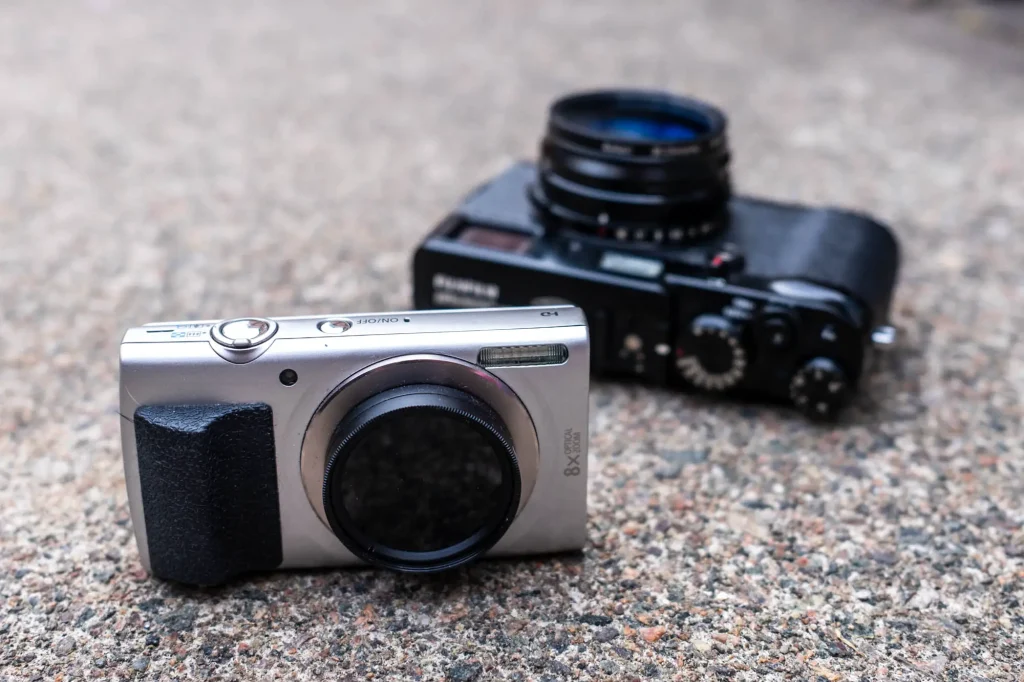
Choosing the X100
Whilst chatting to William at Kolari about my experiences with the Pocket, I also had a second conversation going with him about what higher spec camera I should have converted. We talked through all sorts of options, with the main initial focus being around the idea that I wanted something really versatile. Unfortunately (or possibly fortunately, as it could have been quite expensive) they can’t convert Leica cameras – something about how the hot mirror is attached to the sensor. So that was out.
From there I started looking at Sonys. Most of the Sony cameras and lenses I have access to belong to work, though I can bring stuff home of course. I also own a 24mm f/1.8 Sony/Zeiss lens personally, so started going down the Sony road thinking I could mate something with that and then borrow other lenses from work if I fancied something wider or longer. First we talked about an older APSC model I think, then some of the newer models, and before I knew it I was thinking about a full frame A7. The original A7 can be had quite cheap now, and in fact Kolari sell them ready converted for quite good money. I got very close to pressing the button too, but bottled it in the end. It’s just too much money for something I knew for a fact I wouldn’t use that much.
And then the Fuji X100V was announced, and all of the pieces of the puzzle fell together. I wanted the new Fuji for a start, which was going to mean spending the cash I had allocated to this full spectrum camera idea. But, in buying the Fuji X100V, it would also mean my X100 Classic was all of a sudden going to look a little redundant in the cabinet. Then whilst looking at the front of the old Fuji one day it struck me. Before I somehow managed to talk myself up to a full frame camera, I’d been thinking about how a Sony APSC camera and my 24mm 1.8 lens would probably be most of what I ever needed. And then, here in my hand I had a much smaller camera lens combo with a 23mm f/2 lens on the front. The deal was sealed – the Fuji X100 Classic was to be the camera of choice for modification.
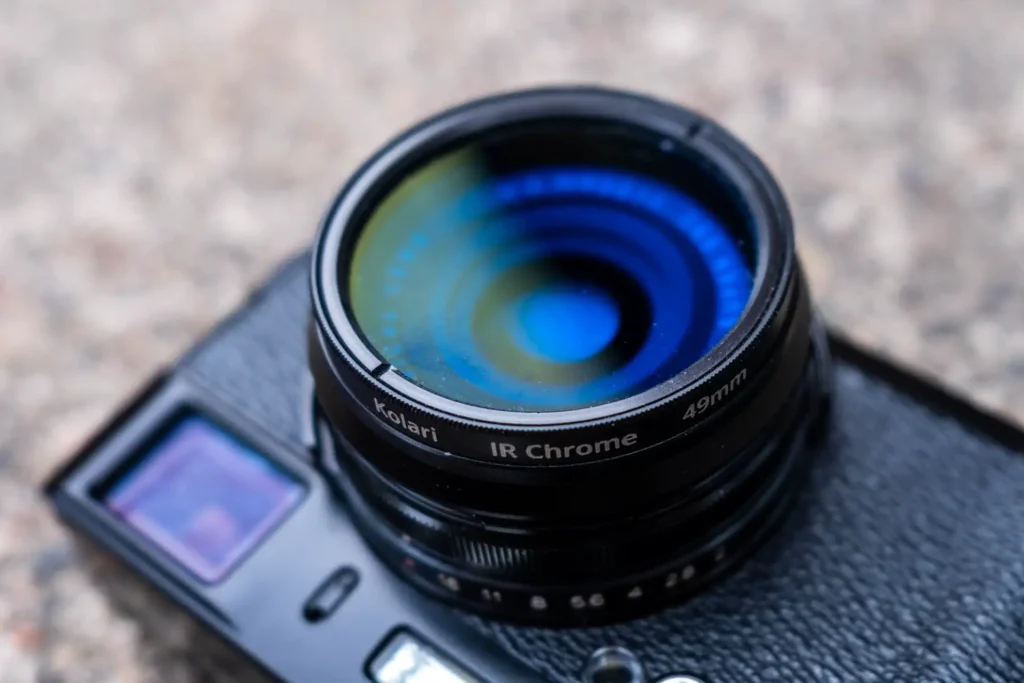
I looked on the Kolari website, and there it was in the list of cameras they can mod, and only $275. A lot less than the $1175 I’d geared myself up to spend on a Sony A7! So off the Fuji went to the states. I must admit, I did get a few pangs of buyer’s remorse after I’d sent it. What if the old Fuji wasn’t up to it? What if the output wasn’t much of a step up from the Kolari Pocket? What if it died soon after spending the cash on it? You know the drill, the “what ifs” around making the wrong choice that always crop up in these situations.
Fortunately, the what ifs would (almost all) instantly turn out to be junk. I had the camera going for about 2 minutes before I realised it was going to do a significantly better job than the Kolari Pocket – which with hindsight felt fairly obvious really. I can, and do, argue until I’m blue in the face about the concept of “better” being subjective when it comes to cameras. The Kolari Pocket certainly wins in the pocketable steaks, but let’s face it, the Fuji X100 is still a “better” camera in practically every other way than the little Canon that the Kolari Pocket is based on. Regardless, the question still remained as to whether or not the Fuji would scratch the itch for a full spectrum modified camera longer-term. Fortunately, after that first shoot down by the river, and a couple of weeks of thinking about it, I think the answer is going to be yes.
The perfect candidate
To be honest, the idea of converting the Fuji had come to mind before. I just don’t think it was until that moment that I focused on the idea properly. When I started to think about it, I started to realise just how ideal it would be. And, as I’ve alluded, now I have the camera I can quite comfortably say that my ideas about why it would work for me have definitely turned out to be right.
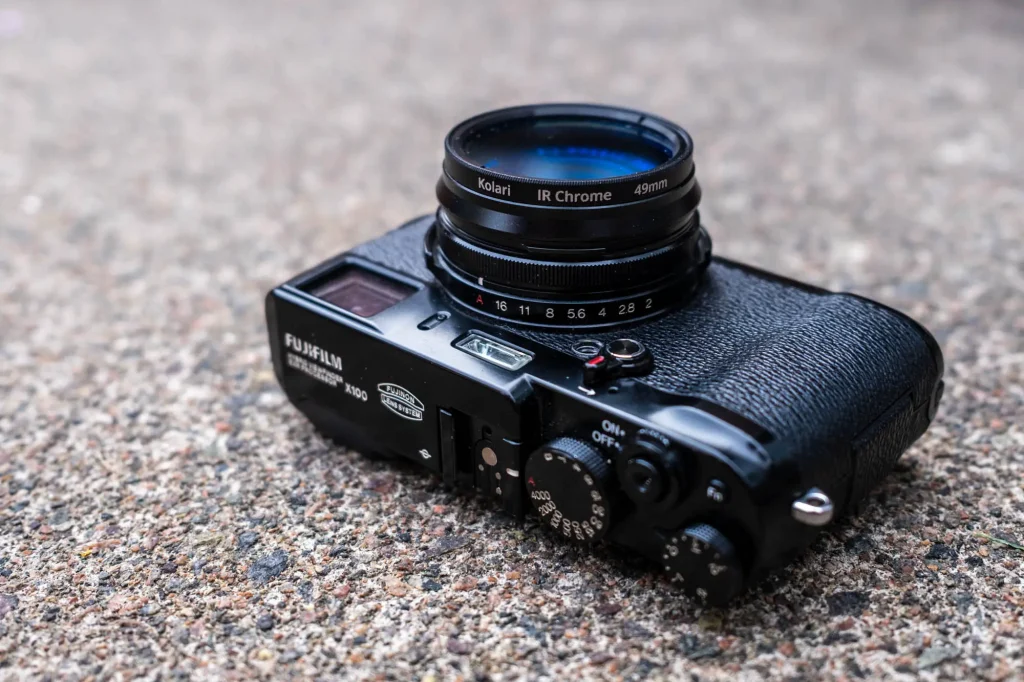
Ideal limitations
Firstly, I really like the original Fuji X100 as a camera. The simple interface, the way it functions as a camera etc – it all just works for me. I do, I will admit, now much prefer the X100V, I’ll be sharing more thoughts about that camera soon, but – spoiler alert – aside for some fairly obvious drawbacks, I really think it’s a quite brilliant camera, and does just about work for me.
What’s specifically relevant to this story is that if there is one thing the X100V does very well, it’s taking photos of the kids – which is something the first one just didn’t do very well at all, despite me trying to force it to.
When I first had an X100 back when they first came out I really wanted it to be better for taking photos of Connie when she was a baby. I got some good shots with it, but fighting the autofocus for good shots of constantly moving subject matter wasn’t that much fun – which was exactly why I sold it. I found this again when I recently re-bought one. For the ~£250 I paid for it, I minded a lot less as I had resigned myself to the idea that it would just become a camera I used a bit like a digital autofocus viewfinder camera for taking snaps whilst out and about.
Of course, the X100V can work like that too. That’s the beauty of this series of cameras, they can be used with just the optical viewfinder for casual snaps with little thought. So as I’ve said, because of all this, the original would become redundant with the new version in the camera cabinet.
This is exactly what also made it perfect for the full spectrum modification. For a start, it would be going unused, but moreover, when I thought about the sort of subject matter I would be shooting with the converted camera, I realised that the shortcomings I find with the original camera weren’t likely to cause me any issues. For a start, I have zero intention of taking photos of my kids with the converted camera. My primary subject matter is always going to be some sort of landscape or urban/city scape. As such, I don’t need excellent eye-tracking high-speed autofocus. And, to be fair, the AF in the original X100 isn’t that bad anyway, it’s just not ideal for taking shots of fast moving kids.
The viewfinder
The nature of the Fuji X100 as a digital viewfinder camera is an advantage too – or at least it is to me. If you don’t already know, the viewfinder on the Fuji X100 is what they call a “hybrid viewfinder”. In practice, this means it gives two options for framing. Firstly, it has a conventional direct view viewfinder that allows you to see the real world when you peer through it. Then, at the flick of a switch, it becomes a digital viewfinder. There are lots of advantages and disadvantages I could talk about when comparing the two, especially on the original version of the X100 – speed of autofocus, quality of the digital image, etc – but none are that important here. With a full spectrum converted camera, it gives you the option to see – or not see – the effect of the modified sensor/filters on the final image.
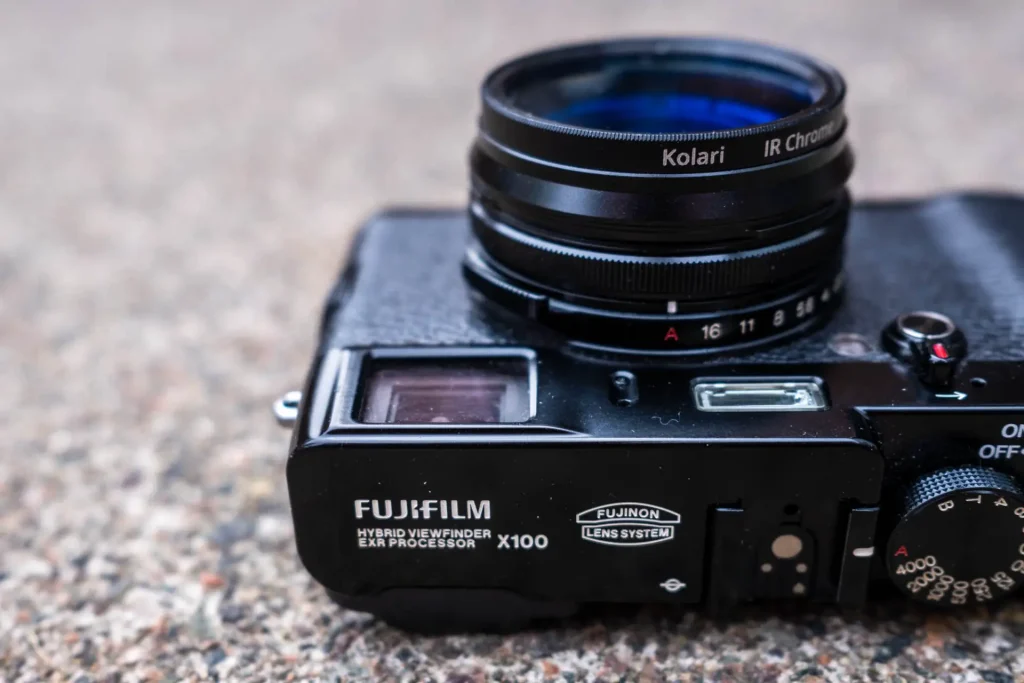
This is quite a big thing for me. I’m quite used to shooting rangefinder cameras which leave a lot of the outcome to the imagination – and I quite enjoy that way of shooting. But, it’s also quite useful to be able to see the effects of shooting a full spectrum converted camera with an IRChrome filter too. The modified Fuji X100 gives both options – which is something very few other cameras offer, not to this degree at least.
The fixed lens
I also realised – even just on the first shooting experience with it – that I didn’t really need anything other than the 35mm f/2 lens. I know for a fact that I can make 35mm work for me, but I often forget that I can. For some reason, I have talked myself into the idea that it’s an “in between focal length” that doesn’t work for me. That’s something I say sometimes anyway, though it’s obviously rubbish as I often make it work with the vast quantity of 35mm lenses point & shoot cameras I’ve shot over the last few years. I do prefer 50mm generally, but actually when I took those first few image, it did remind me just how easy I find it to make this field of view work for me. And, an f/2 lens is plenty fast enough for anything I’m ever going to use this camera for, I’m almost certain of that too.
The sensor
The slightly old sensor was my only other concern about the spec of the camera. In fact, it was probably my main concern after I sent the camera off. Having little previous experience with this type of photography, I didn’t really even have a sense of how good the sensor and image processing needed to be. I knew it needed to be better than the Kolari Pocket, but didn’t know what “better” meant in this context. The one thing I knew I didn’t want to find was the cap on the ability to change white balance that I found with the DNGs out of the Pocket.
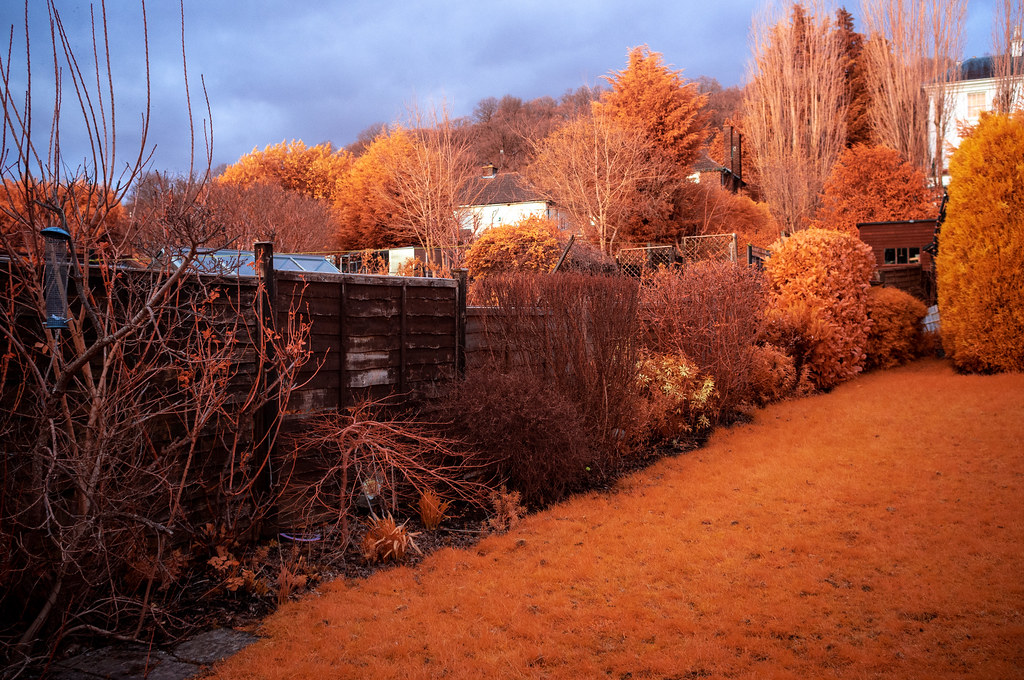
Again, fortunately, it became very quickly apparent that this was not going to be a problem I would face with the Fuji X100. The key differences in terms of the output can be boiled down to it having a much bigger sensor, greater dynamic range, and better in lower light/ higher ISOs capability. The Fuji X100 also shoots RAW files natively. In short, in hindsight, I don’t think this was not a concern I should have bothered myself with really…
If you would like to have a look at the RAW files, I have uploaded them here and included my Lightroom sidecar files so you can see my tweaks too.
Caveat Emptor
So what else is there to be concerned with? Well, I think the age of the camera is probably the thing that I’m left feeling most nervous about. Whilst it might be a later model original X100 (the black ones came later), it’s still an original X100, which does age it somewhat for a digital camera. That said, I do have digital cameras that are a fair bit older that still work absolutely fine and no doubt will do for years to come. It’s just so ingrained into my thinking that 8 years is old for a digital camera that I find it hard not to worry. And actually, that’s despite the fact that I trust Fuji’s build quality a lot more than I do some other brands *cough* Ricoh *cough*. But it’s still a further $275 (plus shipping and import duty) investment on top of the original £250 layout which would be annoying if it did pack up. In short, I’m just crossing my fingers it holds up for a few more years – though I expect it will…
Photos
All of these were taken using an IRChrome filter.
From the flood…
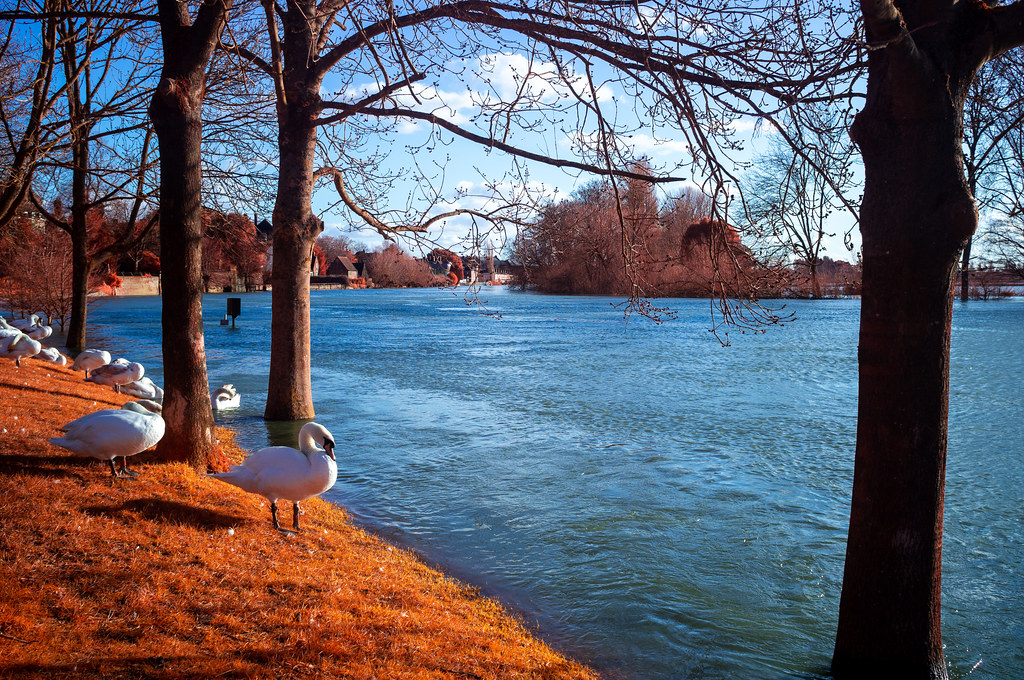
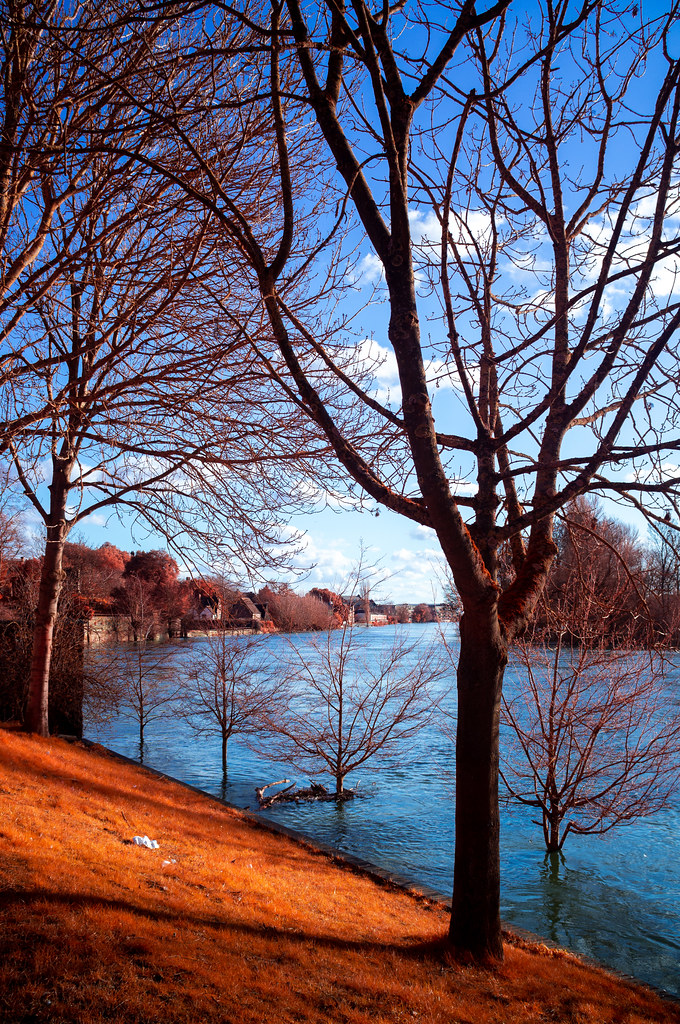
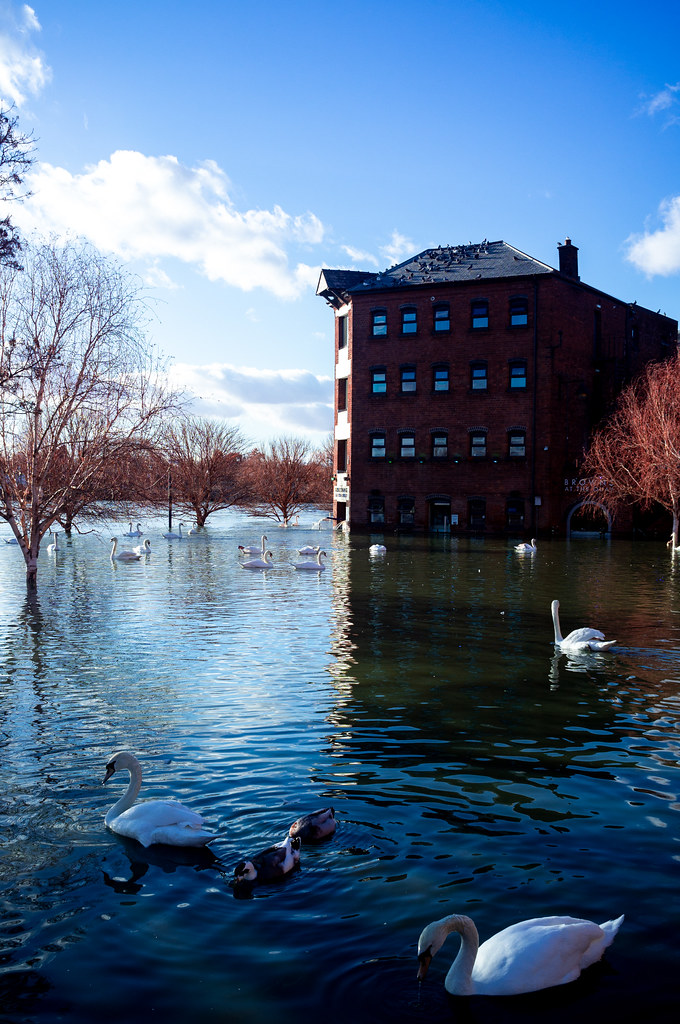
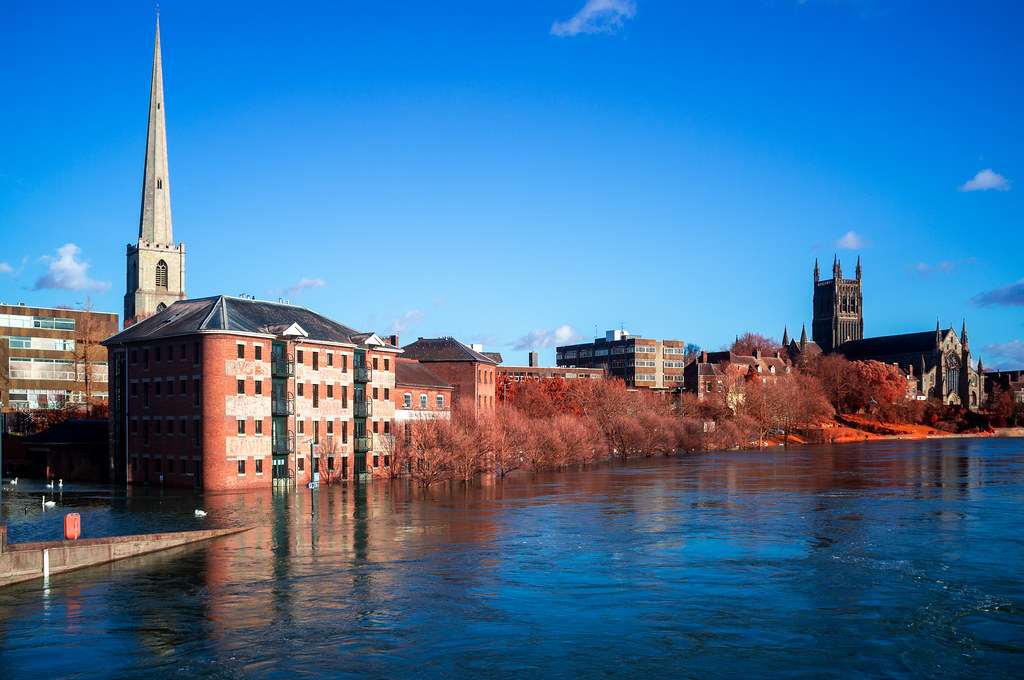
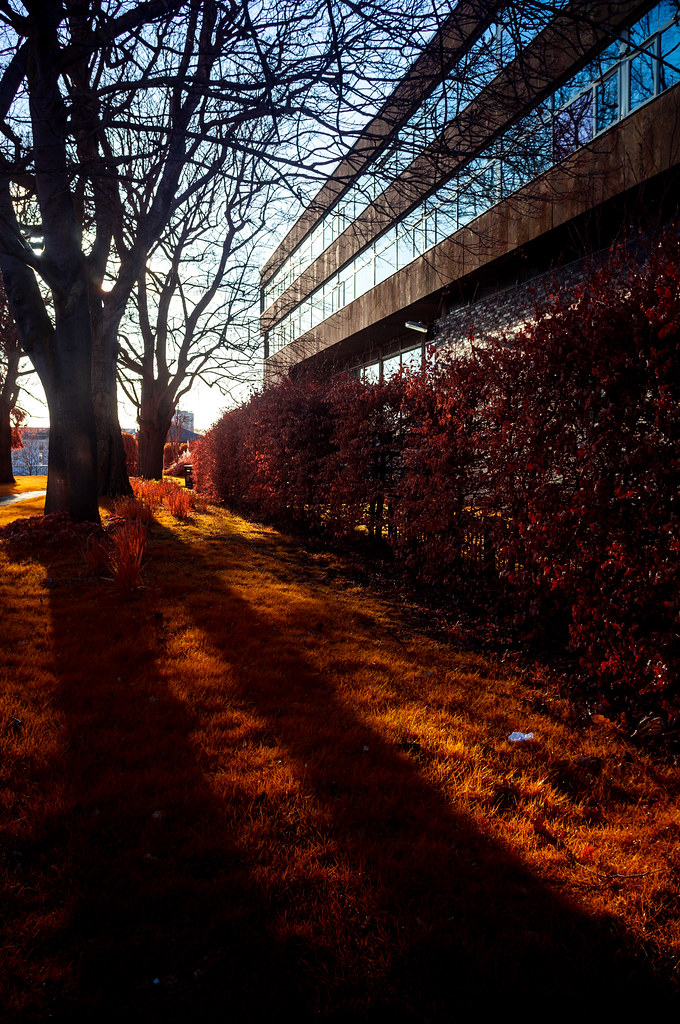
…and from the back garden
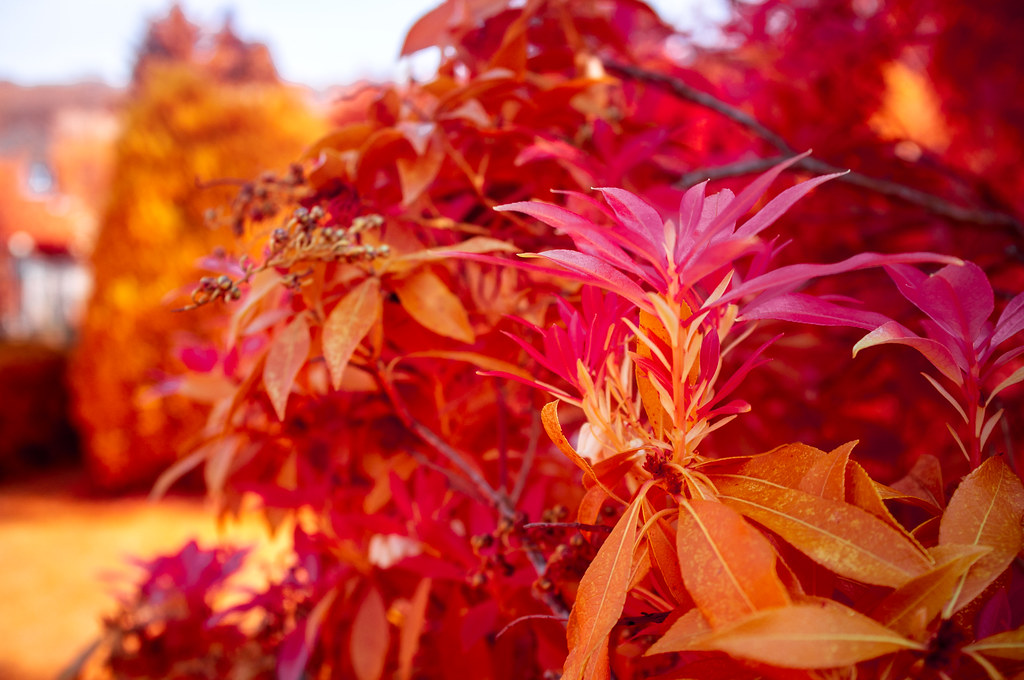
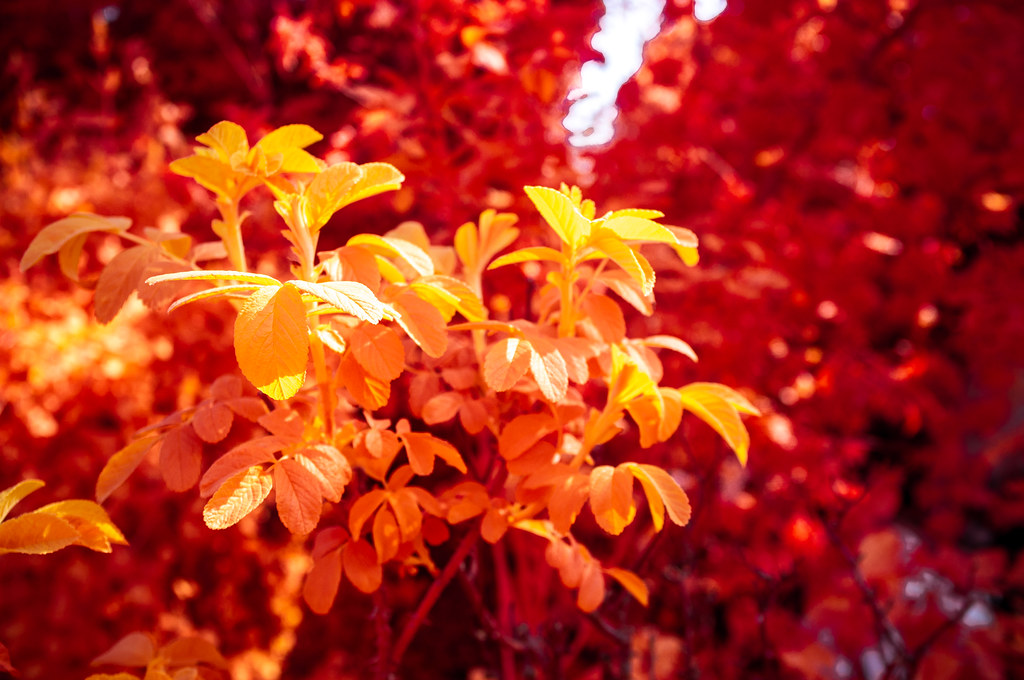
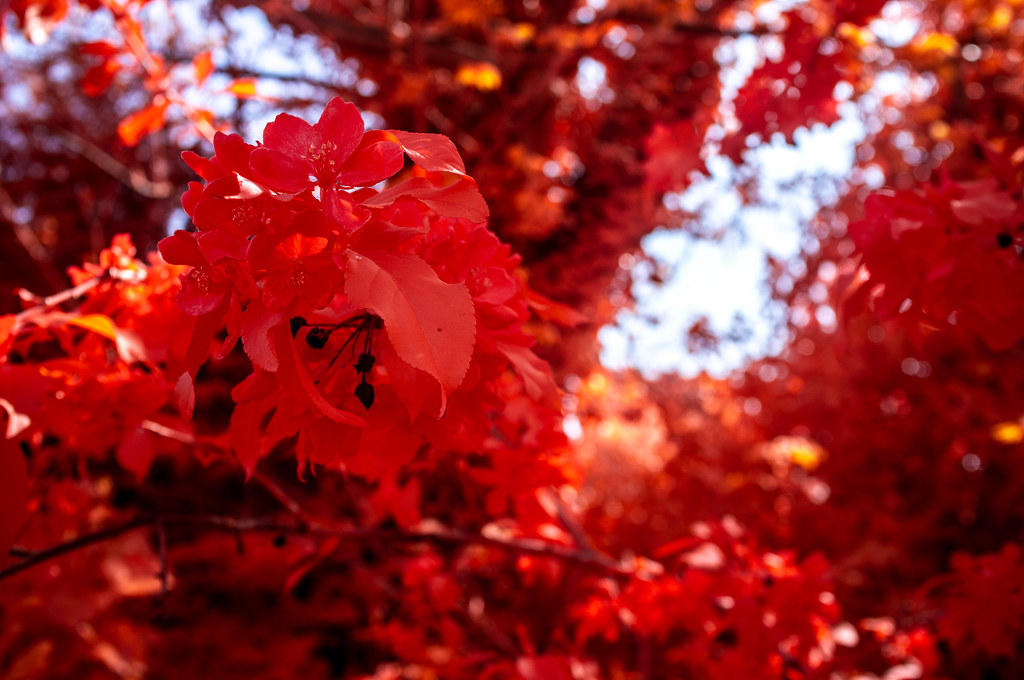
Final thoughts
I say “final” thoughts, but I’ve hardly shot it yet – I’m sure I’ll be back with more pictures in due course. I had a few ideas about what I wanted to do with it when the leaves reappeared on the trees. Of course, now that’s happening we aren’t allowed to leave the house enough for me to do them. Which is mostly why decided to write this now – I’ve had so many questions about it on social media and the like that I didn’t want to leave it until I did have a chance to shoot it again.
Also, as I’ve alluded though, I didn’t feel I needed to shoot it that much to understand whether or not this conversion was the right choice for me. For a start, the files out of the camera are quite clearly to me going to do what I need them to over and above what the Pocket offers me. Which just left the choice of the X100 as being the right camera to modify or not.
I’m almost certain I could have found a way to justify the Sony A7 to myself had Fuji not launched X100v in time for it to turn my head away from the Sony idea. I’m really pleased that did happen though. But for some small reservations I have about the potential longevity of this camera, I do think it makes the ideal platform for a conversion for someone like me. There is a big chunk of this that comes down to the comparatively lower investment – for someone who will use this camera as much as I will, I think it would have been a little daft to spend a lot more money. But actually, there really is a fine balance of features that works well for me here too.
The older model Fuji X100 might not have some of the modern wiz-bang features of the newer model, but for the sort of photos I’m going to take with it, I just don’t need those added features. And in fact, the combination of features it does have suits me very well.
That said, if you asked me if I’d recommend this camera for conversion, I’m not sure I would make a sweeping recommendation specifically for the first version of the X100. If you already have one like I did, then I think it makes a pretty good choice, but for the difference in price between it and either the later ‘S’ or ‘T’ models, if you’re going to seek one out, on balance, it might be a better option to go for one of those models to buy yourself a little more longer-term security.
Either way, certainly at this stage in my path with this camera – and indeed non-visible light photography – I’m definitely comfortable recommending the X100 series cameras as a platform for full spectrum modification by the guys at Kolari Vision. And if you have any uncertainty, you can always drop them an email – they gave me loads of really good advice whilst I was faffing around making my mind up! Just gotta wait for this damned virus to go away so I can use it properly again now…
Finally, if you do decide to buy something from Kolari, they gave me a code that gives you a small discount and me a little kickback too – when checking out on their site, use the code hamishgill
Share this post:









Comments
Bernhard on Fuji X100 – Kolari Vision Full Spectrum Modified – First Impressions
Comment posted: 20/04/2020
nice results. Have you tried to change red with blue channel?
Stay well
Best regards
Bernhard
Comment posted: 20/04/2020
eric on Fuji X100 – Kolari Vision Full Spectrum Modified – First Impressions
Comment posted: 20/04/2020
Thanks so much.
Maybe you have to travel to Japan to continue to test it
Neal A Wellons on Fuji X100 – Kolari Vision Full Spectrum Modified – First Impressions
Comment posted: 20/04/2020
I bought a new X100s in April, 2014 and it changed my photography life. I like all the old-style controls and started becoming a photography nut again, many years after my 35mm film years from the 1960s through the 1990s. Forward to mid, 2017 after I decided to get a newer X-100F, I had the X100s converted to a dual-spectrum camera by Kolari (no UV but visible and IR capable). I have taken many thousands of photos with it and usually carry it with my X100F on photo expeditions or on just the right lighting days, carry the IR only. I absolute love both Fujis and have even added film cameras again, but that's another story.
I started with a 720nm filter, added a 590nm later and more recently a NDVI Blue IR filter from Kolari. While I have used them all, I generally prefer to convert to B&W, only occasionally deciding to use the color edits. I found all three filters do a decent job with B&W. If the old X100s fails me, I'm converting another. Often, IR is my favorite kind of shooting and I was thrilled recently when the foliage returned.
I hope you continue to enjoy your conversion, and your X100V, While I shoot with about a dozen film cameras, these Fujis are my only digital cameras and I like it that way.
I'm looking forward to hearing more on you IR experiences.
Comment posted: 20/04/2020
Comment posted: 20/04/2020
Comment posted: 20/04/2020
Comment posted: 20/04/2020
Tom Brayne on Fuji X100 – Kolari Vision Full Spectrum Modified – First Impressions
Comment posted: 20/04/2020
Comment posted: 20/04/2020
Bruno Chalifour on Fuji X100 – Kolari Vision Full Spectrum Modified – First Impressions
Comment posted: 20/04/2020
Comment posted: 20/04/2020
Comment posted: 20/04/2020
Comment posted: 20/04/2020
Adding Color to Cyanotype - By John Isner - 35mmc on Fuji X100 – Kolari Vision Full Spectrum Modified – First Impressions
Comment posted: 02/09/2020